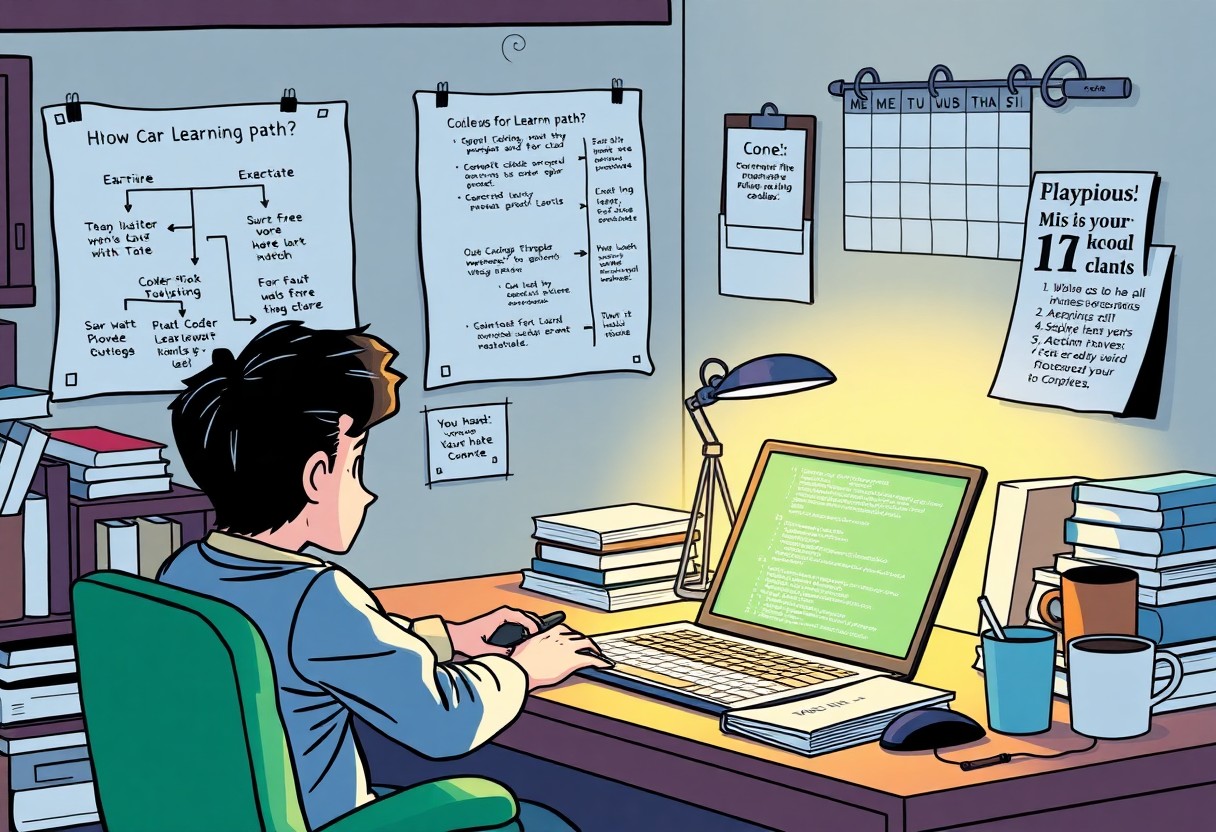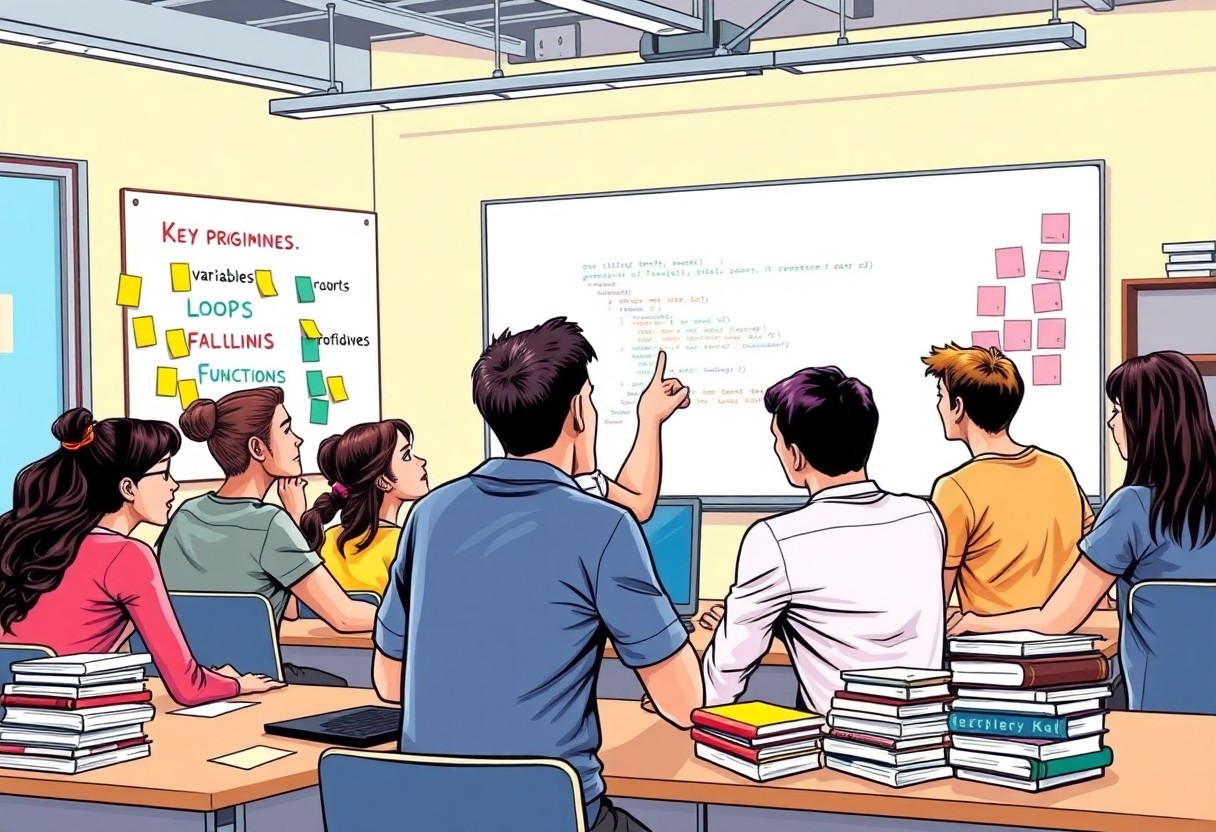This guide is designed for those eager to look into programming, even without a formal computer science degree. I will share my journey and the vital steps you need to take to build your skills effectively. With the right mindset and resources, you can learn programming independently and land a rewarding career. I’ll highlight common pitfalls to avoid, as well as effective learning strategies that can accelerate your progress. Your journey to becoming a proficient programmer starts here.
Key Takeaways:
- Begin with beginner-friendly programming languages like Python or JavaScript.
- Utilize online resources, such as tutorials, coding bootcamps, and forums for support.
- Practice consistently through real-world projects to build a portfolio and gain hands-on experience.
Understanding Programming
Programming involves writing instructions for computers to execute tasks, transforming ideas into executable code. It combines logic and creativity, enabling you to solve complex problems and develop applications that impact everyday life. As you probe deeper into programming, you’ll discover various approaches and methodologies that enhance your coding proficiency and project execution.
What is Programming?
Programming is the process of creating a set of instructions that tell a computer how to perform specific tasks. These instructions are written in a programming language, allowing you to communicate with the hardware to achieve desired outcomes. This can range from simple calculations to developing intricate software applications.
Types of Programming Languages
Programming languages can be categorized into several types based on their functionality and usage. Common categories include high-level languages, which are user-friendly and abstract away hardware details, and low-level languages, which offer more control but require deeper technical knowledge. Other types include scripting languages for automation and markup languages for structuring content.
| Type | Description |
| High-level | User-friendly, abstracts hardware details |
| Low-level | Offers control, requires technical knowledge |
| Scripting | Automates tasks, often interpreted |
| Markup | Structures content on the web |
| Object-oriented | Uses objects to model real-world scenarios |
Familiarizing yourself with the different types of programming languages allows you to choose languages that best suit your project needs. For instance, if you’re looking to build web applications, you might focus on JavaScript or Python, whereas for system programming, C and C++ may be more appropriate. After understanding these distinctions, you can make informed decisions on which languages to learn next.
| Language | Use Case |
| Python | Web development, data analysis |
| JavaScript | Interactive web applications |
| Ruby | Web applications with Rails |
| Java | Enterprise applications, Android development |
| Go | Cloud services and system programming |
Exploring the landscape of programming languages not only enhances your coding toolkit but also opens up new avenues for projects. By understanding the unique strengths and weaknesses of each language, you can select the most effective tools to bring your ideas to life. After this exploration, you will be better equipped to examine practical coding challenges.
Setting Goals
Establishing clear goals serves as a roadmap for your programming journey. By pinpointing what you want to achieve, you can maintain focus and motivation. Start by considering what specific skills you aim to acquire or projects you’d like to complete. Whether you aspire to build an app or secure a job in tech, articulating your objectives will guide your learning path and help measure your progress.
Defining Your Purpose
Defining your purpose is the foundation of your programming journey. Ask yourself why you want to learn to code—perhaps it’s to enhance your career prospects, create personal projects, or simply explore a new hobby. Understanding your motivation not only keeps you engaged but also shapes the programming languages and tools you choose to learn.
Short-term vs. Long-term Goals
Short-term goals provide immediate milestones, while long-term goals shape your overarching vision. Focusing on achievable tasks, such as completing a tutorial or building a small project, keeps your momentum going. In contrast, long-term goals like becoming proficient in full-stack development or landing a job in tech offer a sense of direction and ultimate aspiration.
Breaking your goals into short-term and long-term categories helps maintain balance. Short-term goals could range from completing daily challenges on platforms like LeetCode or building a simple website within a week. These bite-sized accomplishments yield quick wins that build confidence. Long-term goals, such as mastering a specific framework or developing a portfolio over a year, allow you to visualize your growth and progress in relation to your career aspirations. This structure keeps you focused on immediate tasks while still pushing toward significant achievements.

Choosing Learning Resources
Identifying the right learning resources can significantly impact your programming proficiency. With many options available, I found that selecting resources that match my learning style and objectives often led to more effective results. Both structured and self-directed materials should cater to the skills I aim to acquire and the languages or frameworks I wish to explore.
Online Courses and Tutorials
Online courses and tutorials provide a flexible way to absorb new programming concepts at your own pace. Platforms like Coursera, Udemy, and Codecademy offer structured paths with video lectures and interactive coding exercises. These resources can be particularly helpful when just starting, as they often include a community component where you can ask questions or collaborate.
Books and Documentation
Books and official documentation remain crucial tools for deepening your understanding of programming. They offer in-depth insights and comprehensive coverage of specific topics, which can be beneficial as you progress. Often, I refer to well-regarded texts such as “Clean Code” by Robert C. Martin or “You Don’t Know JS” by Kyle Simpson for foundational and advanced knowledge. Exploring official documentation, like the MDN Web Docs for JavaScript, equips you with the latest information and best practices, making it easier to implement solutions effectively. They provide real-world examples and often explore common pitfalls, giving you practical knowledge to build upon.
Essential Tools and Software
To effectively start programming, selecting the right tools and software enhances your coding experience and productivity. Familiarizing yourself with integrated development environments (IDEs), text editors, and version control systems is vital for efficient coding and collaboration. These tools not only improve your workflow but also help organize your projects and keep track of changes, making coding less daunting and more enjoyable.
IDEs and Text Editors
IDEs like Visual Studio Code or PyCharm provide feature-rich environments that streamline coding with functionalities such as code completion and debugging. On the other hand, lightweight text editors like Sublime Text or Notepad++ offer simplicity for quick edits. Depending on your project and personal preference, you might choose an IDE for larger applications or a text editor for smaller scripts.
Version Control Systems
A version control system (VCS) like Git is vital for tracking changes in your code. It allows you to revert to previous versions, manage different project branches, and collaborate with others effectively. This not only safeguards your work but also provides insights into how your project evolves over time.
Using Git facilitates seamless collaboration on projects, especially when working with others. Imagine committing changes to a shared repository, allowing your team to see your updates instantly. Platforms like GitHub and Bitbucket elevate this further by providing a user-friendly interface for managing repositories and collaboration, which can be invaluable in both personal and professional projects. Engaging with version control sets a solid foundation for teamwork and establishes best practices in software development.
Building a Foundation
Developing a solid foundation in programming is vital for long-term success. This stage involves familiarizing yourself with the basic principles and concepts that underpin every programming language. You’ll need to grasp the core ideas such as syntax, data types, and control structures, which are common across languages. I found that dedicating time to these fundamentals pays off immensely, as they help in grasping more complex topics later on.
Basic Concepts of Programming
Understanding basic concepts of programming lays the groundwork for your coding journey. You’ll encounter terms like variables, operators, and functions. For instance, knowing how to declare a variable allows you to store and manipulate data efficiently. I recommend practicing with simple exercises that reinforce these concepts, helping you to build confidence and fluency in programming language syntax over time.
Problem-Solving Techniques
Effective problem-solving techniques are at the heart of programming. Approaching problems systematically, I often break them down into smaller, manageable components. Utilizing strategies such as pseudocode and flowcharts can help visualize the steps needed to achieve a solution. This analytical mindset will support your coding as you tackle more complex challenges.
To deepen your problem-solving skills, I engage in coding challenges on platforms like LeetCode or HackerRank. These platforms offer a variety of problems that require logical reasoning and algorithmic thinking. In addition, refining your ability to debug and iterate on your solutions is equally important. I find that understanding common algorithms and data structures provides a significant advantage, allowing you to efficiently solve problems while writing clean and effective code.
Practice and Projects
Taking your programming skills from theoretical knowledge to practical application requires consistent practice and engaging projects. Tackling real-world problems not only solidifies your understanding but also builds a portfolio that showcases your abilities to potential employers. Set aside regular time for coding, focusing on projects that challenge you while allowing room to grow. Each project serves as a stepping stone toward mastering different languages and technologies.
Small Projects to Start
Beginning with small projects can significantly boost your confidence and skills. Simple tasks like building a personal website, creating a to-do list app, or automating a repetitive task through scripting are great starting points. These projects help you apply fundamentals, experiment with different programming paradigms, and learn to debug effectively. As you complete each one, you will notice improvements in your efficiency and problem-solving capabilities.
Contributing to Open Source
Engaging with open source projects provides invaluable experience and showcases your abilities in real-world environments. By contributing to these projects, you gain insight into collaborative coding practices, version control systems like Git, and the importance of code documentation. This process not only enhances your technical skills but also fosters a sense of community and networking opportunities within the developer ecosystem.
To start contributing, explore platforms like GitHub or GitLab, where numerous projects welcome input from newcomers. Look for repositories labeled with “good first issue” or “help wanted.” Understanding existing codebases can be daunting, but take it one step at a time—reading issues and documentation can offer context. The contributions don’t have to be code-related; they can include enhancing documentation, fixing bugs, or even suggesting improvements. Each contribution, no matter how small, builds your confidence and adds to your professional credibility.
Final Words
The journey to start programming from scratch without a CS degree can be both rewarding and empowering. I encourage you to prioritize practical experience by working on projects that interest you; this will solidify your understanding. Utilize online resources, coding bootcamps, and communities to seek guidance and feedback. I’ve found that persistence and curiosity are key as you face challenges. Embrace a growth mindset, and soon you’ll find yourself not just learning to code, but also creating meaningful programs that showcase your skills.
FAQ
Q: What programming language should I start with?
A: Beginners often find Python to be a suitable choice due to its readability and simplicity. Other options include JavaScript for web development or Ruby for its ease of use.
Q: Where can I find resources to learn programming?
A: Numerous online platforms offer free and paid courses. Websites like Codecademy, Coursera, and freeCodeCamp provide interactive coding lessons, while YouTube has countless tutorials for visual learners.
Q: How can I practice coding effectively?
A: Engage in coding challenges on platforms like LeetCode, HackerRank, or Codewars. Working on personal projects or contributing to open-source projects can also enhance your skills and understanding.
